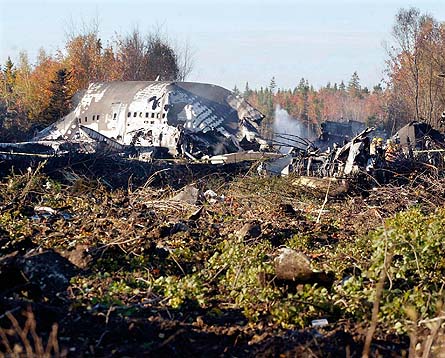Final accident reports and safety studies or analysis published in the first six months of 2006 have concluded, among other things, that aircraft should have take-off performance monitoring (TPM) systems, that air traffic control should avoid vectoring aircraft with significant control or power unit problems over large conurbations, and that a major European nation's total accident investigation system is "dysfunctional".
|
|---|
| The 2004 crash of MK Airlines Boeing 747F has led to a call for take-off performance monitoring systems to be fitted to aircraft |
■ The Transportation Safety Board of Canada (TSB) has recommended that aircraft should be fitted with TPM systems as a result of its finding that the 14 October 2004 MK Airlines Boeing 747F accident at Halifax failed to get airborne because the crew had calculated the aircraft was much lighter than it was. Because the take-off took place at night and the crew was fatigued, they did not notice until too late that the aircraft was accelerating particularly slowly, so it had not achieved take-off speed by the time it overran the runway end. A TPM would have warned them performance was insufficient, the TSB argues. All seven crew died in the accident.
■ The US National Transportation Safety Board reported that fatigue was one of the major causal factors of the 19 October 2004 Corporate Airlines BAe Jetstream 32 accident at Kirksville, Missouri. The crew were flying a night localiser/DME approach at the end of their sixth sector of the day having been on duty for 15h from an early start, which the NTSB says is legal according to Federal Aviation Administration regulations. The NTSB says: "Existing FAA pilot duty regulations do not reflect recent research on pilot fatigue and sleep issues, increasing the possibility that pilots will fly in a fatigued condition." But its only recommendation is that pilots should be provided with "additional fatigue-related training to increase their awareness and use of fatigue-avoidance techniques". Of the 15 people on board, 13 were killed.
■ In late March, the Egyptian civil aviation authority published its report on the 3 January 2004 Flash Airlines accident in which all 13 crew and 135 passengers died. During its night climb out of Sharm el Sheikh, the aircraft went out of control and it crashed into the Red Sea. Accident investigators from the USA and France (the passengers were French) said the accident occurred because of pilot disorientation and that nothing of technical significance explains the disorientation. But Egyptian investigators concluded that the disorientation was the result of distraction caused by possible malfunctions in one or more of four different control system units.
■ After an incident on 24 April 2004, when an Evergreen International Boeing 747-100F developed multiple engine trouble and was vectored over central London into Heathrow at the pilot's request, the UK Civil Aviation Authority reviewed the guidelines for air traffic controllers vectoring a faulty aircraft to a suitable airfield. In this case the aircraft was at 36,000ft (11,000m) when it reported engine trouble. It could have been diverted to numerous large airports clear of conurbations. There was never an attempt by ATC to establish the nature of the cargo, says the report, pointing out that established guidelines do not allow Heathrow and Gatwick to be diversions for aircraft carrying dangerous cargo. In fact the cargo was an aeroengine, and after safely landing at Heathrow no engine faults were found. The CAA says training for this set of circumstances should be included in controllers' initial and recurrent training, but the ultimate decision should be with the aircraft commander.
■ The French ANAE air and space academy says a clash between judicial and technical investigations after aviation accidents in France has produced a "dysfunctional" system that harms the interests of industry and accident victims alike. "The way of conducting civil aviation investigations following accidents [in France] should be revised," says the academy, explaining: "An aviation accident generates two separate investigations that should be complementary." These, says the ANAE, are the legal investigation to establish responsibility and whether there has been a misdemeanour, and the administrative investigation that aims to determine the causes of the accident and draw conclusions needed to devise ways of improving flight safety. The ANAE report says: "These two perspectives on the same accident often seem, in practice, to be in competition, interfering with, rather than complementing each other. Instead they should aim to provide mutual support, while respecting their different respective objectives".
Source: Flight International

















